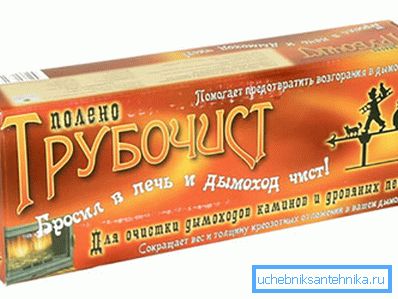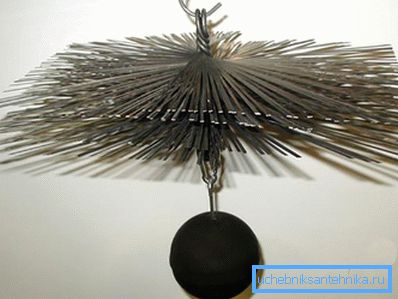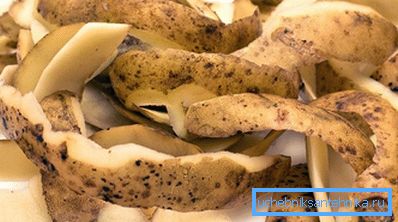How to clean the chimney soot
Every owner of a bathhouse or a house with stove heating should be aware that when burning wood and coal, soot is released. This soot exfoliates from the walls of the chimney and over time can lead to quite serious problems. The functioning of the chimney system will be disturbed, which is quite dangerous, because during combustion many harmful substances are released, one of which is carbon monoxide, which can lead to serious poisoning and even death. That is why the question of how to clean the chimney from soot is very important and everyone needs to know how to do it.
How to determine that the chimney should be cleaned?

At a time when stove heating was almost the only way to warm a home, chimney sweepers were cleaning chimneys (especially in urban areas). It was an independent profession, with its own nuances and wisdom. There were even signs associated with representatives of this undoubtedly necessary craft. However, with the development of central heating technologies and comprehensive gasification, the need for chimney sweep gradually disappeared. But the baths and fireplaces have not disappeared anywhere, so every owner should know how to clean the chimney, especially since with proper skill it is not at all difficult.
It should be said that the cleaning of the chimney should be carried out at least once a year. This is usually done immediately before the start of the heating season. But it often happens that the chimney system is clogged with soot during the operation of the stove or fireplace, and there may be a barrier from the outside, for example, foliage attacks the pipe. This means that you need to know the basic signs that cleaning is already needed.
- The first thing you need to pay attention to the changes in the burden. Anyone who has stoked the furnace at least once knows that it provides the ability to control the intensity of combustion. There are pipe plugs and blew. Plugs regulate the width of the chimney, and the blower provides air flow, without which burning is impossible. With a clean chimney, the plugs never fully open. In this case, the combustion will be too intense, and the heat will go up with the smoke, and not to heat the boiler or the interior. As a rule, the optimal position of the plugs and the blower is determined empirically, and therefore any change will be immediately noticeable. If you need to open the plugs wider than usual to ensure good traction, then the chimney volume has decreased. It is time to free him from unnecessary soot.
- Another sign that it’s time to clean the pipe is the color of smoke. If it passes through the chimney without encountering resistance, then its color will be lighter or completely transparent. If black, swirling smoke comes down from the chimney, this indicates a clogged chimney, and, consequently, the need to clean it.
- The color of the flame inside the oven can also indicate problems with the chimney. The fire should burn brightly and have a rather yellow color. If the shade of flame leans towards orange, it means that the above gases do not go completely. At the same time, additional soot is released, which only worsens the situation. And this is fraught with serious, if not to say dangerous consequences.
These are just some signs, but at the same time they will be quite enough to determine the moment when cleaning the chimney becomes a necessary action.
Ways to clean the chimney
It should immediately be said that the chimney pipe cleaning can be done in several ways. You need to choose the most effective and convenient, and for this it will be useful to get acquainted with all.
Chemical reagents
Due to the development of the chemical industry, a variety of compounds and substances used in all areas of life. So, in particular, special reagents are used for cleaning chimneys. These chemicals are usually required to be burned together with firewood or other used fuel. As a result of combustion, substances will be released that will destroy the integrity of the soot in the chimney. Soot will crumble down and will only remove it from the special cleaning holes with a scoop. Usually this method is used together with others, but in cases where there is a slight pollution of the chimney, they can be dispensed with.

This method is undoubtedly convenient. To clean the chimney with chemicals, no effort is needed, and specialized knowledge is not useful. Simply add the agent to the fuel used. Some chemical means of cleaning chimneys even come in the form of logs (apparently, for greater ease of use and clarity).
Tip! When using these substances it is necessary to strictly comply with the instructions and safety instructions.
Mechanical cleaning
Another way to clean the chimney from soot and soot is its elemental removal with the help of various devices. In this way, pipes have been cleaned from time immemorial, and it must be said that it is not in vain. The method is simple and extremely effective. But it should be said that to clean the pipe in this way will need to climb on the roof, therefore, the work will be associated with considerable risk. Therefore, compliance with safety regulations during the work is mandatory.

The meaning of the work lies in the fact that with the help of special brushes and brushes the chimney mechanically gets rid of soot. For these purposes, a brush of sufficient thickness is usually used with a load suspended from it. It is worth making a reservation that some "craftsmen" are tied to the brush weights that fit the pipe in diameter, which, to put it mildly, is not quite true. The fact is that the weight has a displaced center of gravity, and she can, having turned on him, get stuck in a pipe. For best results, you should use finished products that can be found in stores.
So, with the help of simple vertically directed reciprocating movements, mechanical removal of soot occurs. However, this method has one major drawback - only straight and even pipe sections can be cleaned. For example, a fireplace chimney. If there is a complicated chimney having bends, then you need to use chemical means.
Folk methods
Of course, speaking about how to clean the chimney, you can not ignore the popular methods. They are often no less effective than specialized, but cheaper. For example, potato peelings can be used as a substitute for chemicals. To do this, a bucket of dried cleaning should be poured into the furnace during the burning of fuel. The fact is that the starch contained in the potato skin during combustion will release substances that will destroy the soot layer, and it will simply crumble down.

Tip! To achieve the best efficiency, it is better to repeat the procedure several times.
Thus, not only the disposal of food waste, but also the cleaning of the chimney will occur. And it should be said that this homemade product has sufficient effectiveness, especially in combination with mechanical cleaning. In addition, it is completely free.
Another popular way is temperature cleaning. The stove is heated by dry aspen wood. When they burn, a very high temperature is formed, with the result that soot simply burns. It should be said that this method of cleaning is rather doubtful.

It will probably have efficiency, but at the same time there will be a very large thermal load on all elements of the furnace and chimney, which can lead to their destruction. This in turn can cause a fire. So it is better to refuse this option. For completeness, we can mention the addition of naphthalene to the fire. When it burns, it will emit substances corroding soot.
Tip! This method is extremely dangerous, since the same substances with equal efficiency corrode the mucous membranes of the human respiratory tract, therefore, cleaning chimneys in this way is strictly prohibited.
Deciding which way to clean the chimney from the accumulated soot should be chosen independently and for each particular case separately. We can only add that it is better to simply prevent the formation of a thick layer of soot. As a preventive measure, for example, we can mention the addition of table salt to the fire. Then the soot simply will not for some time settle on the walls of the pipes, which will relieve from many problems.
Video
We offer you a video showing the process of cleaning the chimney with firecrackers.